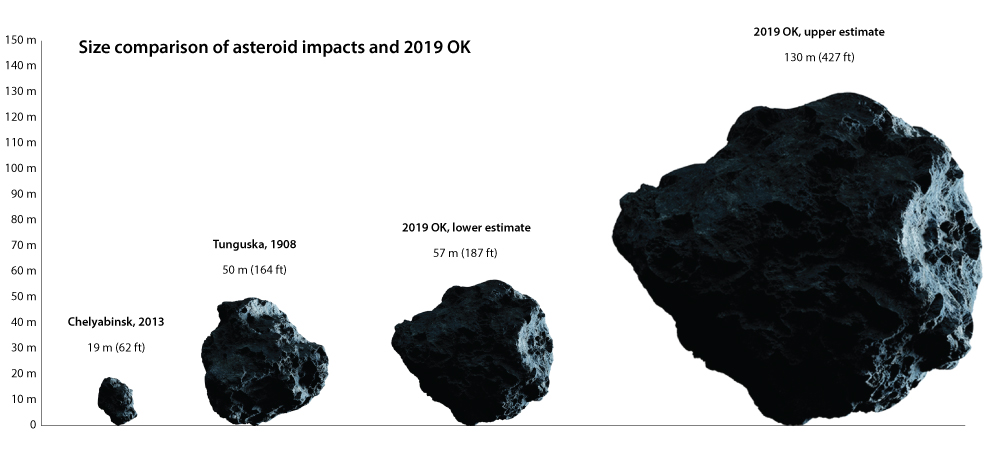
26th July 2019 Large asteroid approaches Earth undetected Astronomers report that "2019 OK", a previously undetected asteroid, passed within just 72,500 km (45,000 miles) of Earth on 25th July 2019 at 01:22 GMT. This object, moving at 88,500 km/h (55,000 mph), is estimated at between 57 and 130 metres (187 to 426 feet) in size. Taking the upper value, it can be calculated that a 45° impact – if occurring on land – would be equivalent to more than 100 megatons of TNT. For comparison, the Tsar Bomba, famous as the most powerful nuclear weapon ever detonated, had only around half as much energy. Additional calculations indicate that the object would leave a crater measuring 2.61 km (1.62 miles) in diameter, with a depth of 556 metres (1,820 feet). The alarming discovery, made just days ago by the Southern Observatory for Near Earth Asteroids Research (SONEAR) in Oliveira, Brazil, is a reminder of the often overlooked dangers of near-Earth asteroids.
For objects measuring around 130 metres (426 feet), the average interval between impacts is 12,000 years. However, smaller bodies that are within the same order of magnitude arrive far more frequently and still have potential to cause tremendous damage. This can be seen with Chelyabinsk (2013), Tunguska (1908) and other relatively recent examples. 2019 OK has now passed harmlessly by – and a highly elliptical orbit makes it unlikely to approach this close again. However, its late discovery underscores the need for improved detection methods and should spur policymakers to take the issue more seriously. Not only do these dark objects need to be found, but ways of deflecting or destroying them need to be researched. A study earlier this year concluded that asteroids may be harder to destroy than previously thought. Countless other asteroids lie undiscovered throughout our Solar System, some in Earth-crossing orbits that will inevitably lead to direct hits in subsequent decades and centuries. It is a question of when, not if, these impacts occur. In 2012, the B612 Foundation – a U.S. non-profit organisation led by scientists, engineers and former astronauts – announced plans to design and build a new space observatory, the Sentinel. This would locate 90% of asteroids greater than 140 metres (460 ft) in near-Earth orbits. However, the fundraising campaign was a failure, with only $3 million being raised of the estimated $450 million needed for operation. A more promising effort is the Near-Earth Object Camera (NEOCam) – a space-based infrared telescope designed to spot 10 times more near-Earth objects than all NEOs discovered to date, including two-thirds of missing objects in the larger-than-140-metres category within four years. NEOCam was proposed in 2015 as part of NASA's Discovery Program, during which it competed with four other candidate missions. While unsuccessful on that occasion, it remains an active project and continues to be studied. There are calls to fund the mission from somewhere besides the Planetary Science Division – such as the Planetary Defense Program or even directly from Congress itself, since it represents a public safety issue. The total cost of the NEOCam telescope is estimated to be $500 to $600 million.
Comments »
If you enjoyed this article, please consider sharing it:
|








